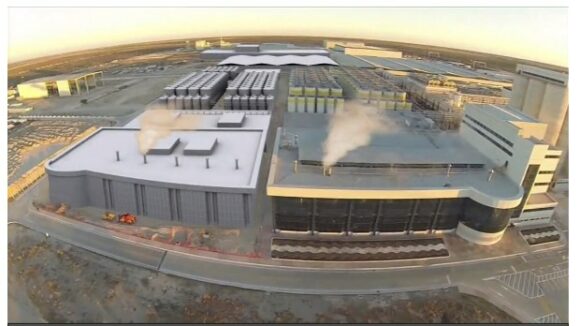The Nava brewery, which started operations in May 2010, was built by Grupo Modelo but subsequently sold in 2013 to Constellation Brands, the U.S. company that holds the rights to import Modelo products into the U.S.
Constellation Brands (founded in 1945 and based in Victor, New York) is a leading international producer and marketer of beer, wine and spirits with operations in the U.S., Canada, Mexico, New Zealand and Italy.
The Nava brewery is the world’s largest brewery of its kind (see this video overview from company webpage), with about 2000 employees and a brewing capacity of 20 million hectoliters of beer a year. A planned expansion (see 26-second video) will increase capacity to 30 million hectoliters.The plant produces Grupo Modelo brands such as Corona, Corona Light, Negra Modelo and Modelo Especial, under license for export to the U.S.
Where is it?
The beer brewery and bottling plant is located in the Nava municipality in the northern state of Coahuila, about 21 km (13 mi) from the border town of Piedras Negras. It is built alongside highway 57 and spreads over 334 hectares (825 acres) of a greenfield site.
Why is it located in Nava?
The major advantages of this location include:
- the availability of good quality water
- proximity to the U.S. border and the U.S. beer market
- presence of good road, rail and power infrastructure
How does the brewery work?
The brewery is a three-story brewhouse with large metal silos, about 1.6 km (1 mi) of conveyors and four pasteurizers. The facility consists of two brewhouses with malt intake, vacuum evaporation and energy recovery systems, 70 cylindro-conical fermentation and storage tanks, seven clean-in-place (CIP) stations, a yeast cellar with 16 tanks and continuous microfiltration (CMF), 30 pressure tanks and three filtration lines with 1,200 hectoliters/hour capacity each, and a Siemens automated process control system.
The brewery uses rice, barley malt, corn grits and water to produce beer. The feedstock is transported by trains to the plant and stored in silos. A 60 km (37 mi) pipeline connects the brewery to a mountain aquifer supplying about 20 million cubic meters of water a year. The site includes its own wastewater treatment plant.
A raw materials supply system handles the raw materials in bulk and conveys them to the brewhouse, where they first enter a collection bin, and then a mash tun, where water is added. The mixture is then pumped along a pipeline to the cereal cooker of the brewhouse.
Two brew systems consisting of mash tuns and cereal cookers are designed to efficiently use the internal heat. These heaters can also clean them automatically by CIP (clean-in-place) technology. Fermentation takes place in unitanks configured with automated clarification, purging systems and turbidity monitoring. The brewery consumes less than 3 liters of water for each liter of beer. The carbon dioxide reclamation capacity of the brewhouse is about 4,000 kg/hour.
The three bottling lines have the capacity to handle 144,000 bottles/hour, while a canning line outputs up to 66,000 cans/hour.
Filling, pasteurizing and cap feeding is handled by 37 robotic machines. Output is linked to the warehouse by automated trolleys. The automated warehouse is equipped with digisat satellite, a state-of-the-art warehouse management system, and can store about 63,000 pallets.
The high level of automation means that this beer manufacturing and bottling plant has operational costs about 40% lower than the seven older breweries that still belong to Grupo Modelo.
Related Posts:
- Mexico’s beer industry loses its national identity (Aug 2012)
- The emergence of two major beer-makers in Mexico (Sep 2010)
- The geography of Mexico’s beer industry (Jan 2015)
- Mexico is the world’s leading exporter of beer (Nov 2014)
One Response to “Nava brewery in Coahuila: the largest brewery of its kind in the world”
Sorry, the comment form is closed at this time.

I accumulate around 1to 2000 42×37 (Corona pallets) a week here in Houston Tx.. Would there be interest in these pallets at your plant? Thank you. Randy Wright Wright Industries rbwright40@yahoo.com 713 984 1307